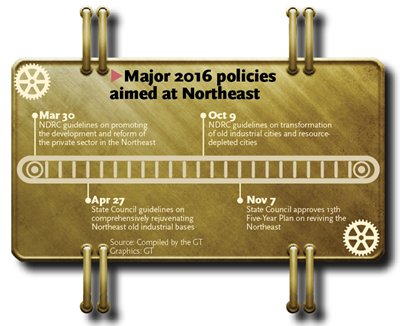
Gov't stresses reforming SOEs, pushing private economy
The latest document issued by the State Council concerning the revitalization of China's Northeast highlighted specific targets as the central government remains determined in pushing forward regional economic reforms, but experts caution that challenges persist.
The average economic growth rate in China's three northeastern provinces - Jilin, Liaoning and Heilongjiang - has been relatively low in recent months, said Zhou Jianping, head of the northeastern region revitalization department of the National Development and Reform Commission (NDRC).
From January to September, Liaoning's GDP contracted by 2.2 percent and Heilongjiang's GDP growth rate came in well below the national average of 6.7 percent. Jilin was the only province whose growth accelerated, reaching 6.9 percent.
"It's unlikely that regional GDP growth will continue to slump in the future, but Liaoning has been struggling the most, so more has to be done," Zhou said at a press briefing on Thursday, noting that Heilongjiang also needs to make more effort, while Jilin is expected to maintain its momentum.
The press briefing was held shortly after the State Council, China's cabinet, issued a new document on regional revitalization. According to the document published on the central government's website Wednesday afternoon, more effort should be made in the next one to two years, including deepening State-owned enterprise (SOE) reform, boosting the private economy, upgrading low-end industries, slashing overcapacity and improving policy-making mechanisms.
Chinese authorities have been working to stimulate economic growth in these three provinces in recent years, but there has been little significant progress.
"When talking about regional economic status, we see four major areas - eastern, central, western and northeastern, the last being the only one that has recorded bad performance in general," Sun Zhiming, an expert at Jilin Provincial Academy of Social Sciences, told the Global Times Thursday. "The central government is very worried about this situation."
In March, the NDRC issued guidelines on promoting development and reform in the Northeast's private sector. A month later, the State Council unveiled guidelines on comprehensively rejuvenating old industrial bases in the region. And on November 7, the State Council approved the 13th Five-Year Plan on reviving the area.
"Those documents are relatively vague in terms of how to work on this revitalization process, but the newest one sets specific targets and tells us what to do," said Liang Qidong, vice president of Liaoning Provincial Academy of Social Sciences.
"The business environment in these three provinces is bad, as they were the first places where the planned economy mechanism was implemented, but was phased in at the slowest pace," he told the Global Times on Thursday.
Boosting the private economy
In the latest document, the government emphasized boosting the private economy. For example, at least one private bank should be established in the region by June 2017.
Among the country's 500 strongest private enterprises nationwide in 2015, only 10 came from these three northeastern provinces, noted Zhou from the NDRC. Additionally, many private companies in the region are concentrated in production, with few in the services sector or high-end industries.
"Local governments control too much, and they have played a major role in attracting investment and business so that local enterprises have been marginalized," Liang said.
Some local governments have taken action in breaking this backward model. Liaoning approved the first batch of public-private-partnership in August, with a total investment volume of 25.4 billion yuan ($3.7 billion), of which 18 billion yuan has been earmarked for private entities.
In order to learn from more developed areas where the private economy has been booming, a cooperative mechanism has been set up by the central government. Through this plan, Liaoning and East China's Jiangsu Province could share experience by exchanging officials and finding complementary sectors, the government document noted.
Breaking SOE monopolies
Another reason behind the regional economic struggles is that a large part of the sectors are controlled by companies backed by local governments or SOEs, experts said. "It's a historical issue, which should be effectively tackled," Sun said.
By the end of 2017, the provinces are expected to make concrete progress in breaking up the outdated collective factories model and introducing mixed-ownership in 10 to 20 local SOEs.
The collective factories model has been spreading in the northeast provinces over the past three decades, which is seen as one outcome of a planned economy. Under this model, local SOEs provide financing to build up new affiliates and recruit relatives of their employees.
"[Regional economic growth] really depends on local SOEs in terms of pushing forward reforms in the corporate structure, but tackling the collective factories model would cost more than 300 million yuan, which is a financial burden for local authorities," Liang noted.


















































